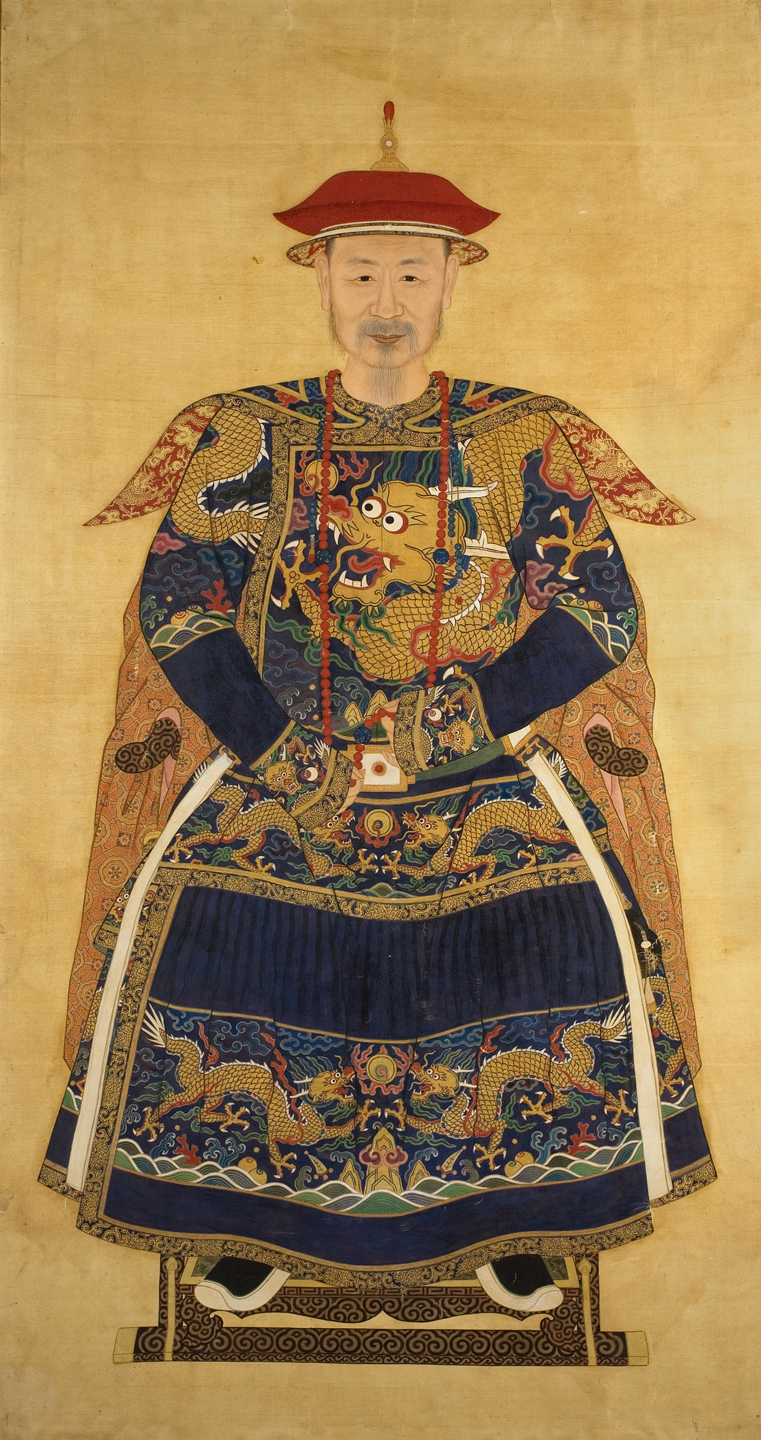Students will examine and discuss the Stela and note that it is an artifact that tells us a story about a powerful Maya ruler. Students will create a symbolic representation of their own personal story, recording how they wish to be remembered. This design will be carved in bas-relief on a clay slab.
Students will be able to:
- describe and analyze what they see in the Stela;
- discuss symbolic meaning and intent found in a work of art;
- identify and relate connections between geographic regions and artistic representations; and
- create a symbolic representation of their own personal stories.
Lesson
Day 1
- Show students the image of the Maya Stela. Conduct a critical examination and ask if they see any clues that might tell us what the object is made from, who may have made it, where it’s from, and what its age might be.
- Share with students the information from About the Art. Point out that the Maya word for artist translates to “wise man” or “sage” and discuss thoughts on why this might be so. Note that at this time only a small number of people, the ruling elite and artists, could read and write.
- Point out the information in the “Details” section of About the Art and identify those things on the Stela.
- Discuss how this artifact tells the story of a powerful Maya ruler. List the ways that we can “read” this information on the object, such as: in the translation of the hieroglyphs, the stance the man takes, the action he chose to have portrayed, the symbols and clothing he chose to be surrounded by, the choice of room depicted in the work, and also where it was displayed.
- Artifacts such as this tell a story. Have students imagine the artifacts from our society that future archeologists will find. What will they say about us? How might they interpret our artifacts? Can they think of any objects that could lead to a misinterpretation of our time or culture?
- Ask students to imagine how they would portray their stories in a stela for future generations. Start by asking: What is your story? How would you like to be remembered? What are some of your accomplishments? Let them take a few minutes to think this through and write thoughts on a piece of sketch paper.
- Have students sketch ideas of how these things could be visually represented.
- Tell students they will be carving their own clay stelas, and have them sketch out a rough draft of what their stela might look like. They could ask a neighbor to pose so as to capture the intended stance of their representation.
- Review what was learned from the Maya Stela and note how the artist used negative space to call attention to his designs. Encourage students to think about the positive and negative spaces in their story sketches. What areas will be left raised and what will be removed? Have them lightly shade in the areas that they will remove. They might wish to consider a design with several layers of depth. Shade each of those layers in a different shade. This will help as they begin the bas-relief carving the next day.
Day 2
- Review what students learned about the Maya Stela in the previous class and have them share their stela drawings with a partner.
- Today, each student will create a bas-relief sculpture in clay displaying their own personal story. Make sure work areas are covered with plastic or paper and that each student has clay and access to clay tools.
- Have students create a slab of clay about two inches thick.
- They should draw their stela design on the slab using a needle tool or a toothpick.
- Tell students to use clay carving or loop tools to remove the negative space (the space they shaded in on their drawings) around the designs that they choose to leave positive.
- When finished, let the clay dry flat or fire the pieces in a kiln. Cover loosely with plastic so that the clay dries slowly and will be less likely to curl or crack.
Materials
- Sketch paper for each student
- Pencils for each student
- Approximately one pound of clay for each student, type dependent on capabilities of the facilities
- Color copies of the image for students to share, or the ability to project the image onto a wall or screen
- Clay carving tools or loop tools, needle tools, or toothpicks
- Rolling pins, for every 3-5 students
- Plastic or paper to cover tables
- About the Art section on the Stela
Standards
- Visual Arts
- Invent and Discover to Create
- Observe and Learn to Comprehend
- Relate and Connect to Transfer
- Envision and Critique to Reflect
- Collaboration
- Critical Thinking & Reasoning
- Information Literacy
- Invention
- Self-Direction
Stela with Image of Standing Ruler Burning Offerings
Maya peoples have lived in what we now call Central America for at least three-thousand years. Their territory included parts of present-day Mexico, Guatemala, Belize, El Salvador, and Honduras. Archeologists divide the ancient Maya civilization into three major time periods: Preclassic Maya (1500 B.C.–A.D. 250); Classic Maya (A.D. 250–900); and Post Classic Maya (A.D. 900–1500).
This wall panel was created during the Classic Period, which is considered the high point of Maya culture. The Classic Maya built cities with palaces, pyramids and temples to honor their gods, and made works of art in a variety of media. They are well known for their sophisticated hieroglyphic writing system, a number system that included the concept of zero, and a calendar for recording both historical and mythological dates. Expert astronomers, the Maya observed the movements of the planets and accurately predicted eclipses.
Maya artists were specialists who produced ceramics, stone sculptures, and jewelry of jade and shell. The Maya word for artist is its’at, which means “wise man” or “sage.” Maya scribes carved inscriptions in stone, and painted them on ceramics and in books made of fig bark paper. Hieroglyphic inscriptions recorded dynastic histories, including births, deaths, and marriages. Military victories and religious ceremonies were also recorded. Like artists today, some Maya artists even signed their works.
This carved limestone slab was a wall panel from a Maya palace or administrative structure. Maya rulers commissioned stone monuments to glorify their ancestry and to proclaim their wealth, taste, military victories, and spiritual power. The image shows a Maya ruler performing an incense scattering ritual that celebrates the end of a 10 year period called a lahuntun. Along the left side of the panel, and across the top are individual signs called glyphs. The glyphs represent words or syllables that can be combined to form words. The glyphs on this panel show the date December 2, A.D. 780.
We know of two other stone carvings of this ruler, one in a private collection in Mexico, and the other in an Australian museum. These carvings suggest that he was an important ruler in his day. In both carvings, the man’s distinctive facial features are clearly identifiable and he is shown grasping prisoners by the hair.
Details
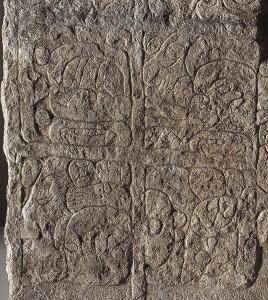
Glyphs
The hieroglyphic text forms a wall and ceiling around the figure, suggesting that he is standing inside a building. The Maya developed their own system of writing, which archeologists consider to be the most sophisticated ever developed in the Americas. The written language consists of hundreds of individual signs, called glyphs, which are paired in columns that read from left to right and top to bottom. The Maya writing system allowed room for artistic expression, so Maya glyphs are often quite elaborate. The first nine glyphs in this carving record the date; the tenth glyph is the verb; and the remaining thirteen glyphs describe the ruler. From the glyphs we know that the ruler was the master of a captive named Yax-ik’nal, and that he captured fourteen other prisoners, which suggests that he was very successful in battle. The glyphs also tell us that the ruler was at least 41 years old, and no older than 60, at the time the stela was made.
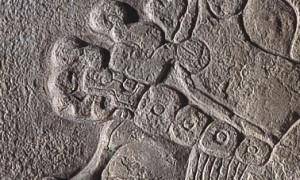
Jeweled Headband
The man in the monument can be identified as a ruler because he wears a jeweled headband around his forehead called a sac hunal, which means “resplendent one.” It is similar to a crown and would have been tied around the ruler’s head when he came to power. In the center of the headband is the head of a deity, which was usually carved in jade. The deity wears a long, three-pointed cap and is nicknamed the “jester god.”
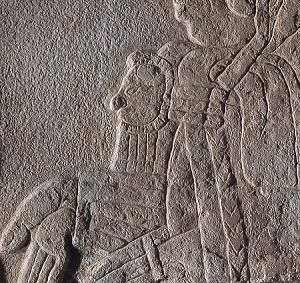
Ornaments
The ruler wears a jade ornament in the shape of a head on his chest. Long quetzal feathers decorated with jade beads fall down his back. Both of these ornaments are signs of his powerful status.
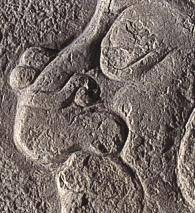
Distinctive Facial Markings
Notice the figure’s heavily lidded eye, the swirling line on his nose that could be a facial scar, and jade bead ornaments on his nose.
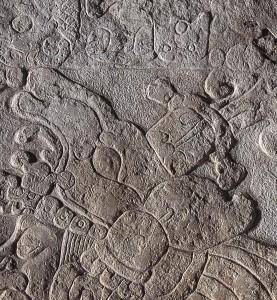
Headdress
On top of the ruler’s headband sits a jaguar head. Above that is the glyph ak’bal, which means “darkness.” Smoke or fire rises out of the ak’bal glyph.
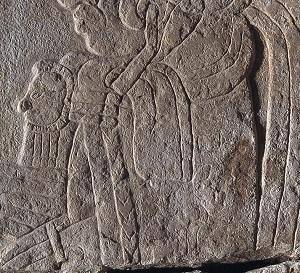
Clothing
The man wears a knotted scarf around his neck and a long cape decorated with three human eyes. Both of these are part of the special clothing the Maya wore when performing sacrificial rituals.

Incense Bag
In this ritual, the ruler is shown scattering incense. His left hand holds a long bag containing the incense, and his right hand is in the scattering gesture. At his feet is a large basket containing long strips of paper and a small tied bundle.

Empty Space
The empty space between the figure and the glyphs emphasizes the outline of the figure, particularly in the areas around his face and headdress.
Funding for object education resources provided by a grant from the Morgridge Family Foundation. Additional funding provided by the William Randolph Hearst Endowment for Education Programs, and Xcel Energy Foundation. We thank our colleagues at the University of Denver Morgridge College of Education.
The images on this page are intended for classroom use only and may not be reproduced for other reasons without the permission of the Denver Art Museum. This object may not currently be on display at the museum.





